Looking back on the production system utilised over 20 years ago for producing rams for sale, Neil McGowan says it was appalling how much concentrates they were feeding rams to prepare them for sale.
He describes how the farm’s breeding programme found itself caught in an “increasingly competitive feeding race”.
It was a situation which was neither working for the farm or the producer purchasing these rams. The severity of the situation really hit home through attendance at discussion group meetings.

The view of the farm looking north showing the type of terrain at the higher elevation.
“Twenty odd years ago, May lambing was nothing new but there was a college [SRUC] group run by John Vipond and I would go a long to a lot of meetings.
“We were learning from each other’s mistakes and at the end of every meeting, the conclusion to many things was that it was the ram breeder’s fault. As a ram breeder I kind of took that to heart when it was raised that there were too many lamb losses, lambs would not get up to suckle quickly and were not vigorous enough and it was down really to ram breeders not doing their job. It got us thinking what if a ram breeder tried to do it right from a commercial farmer point of view.”
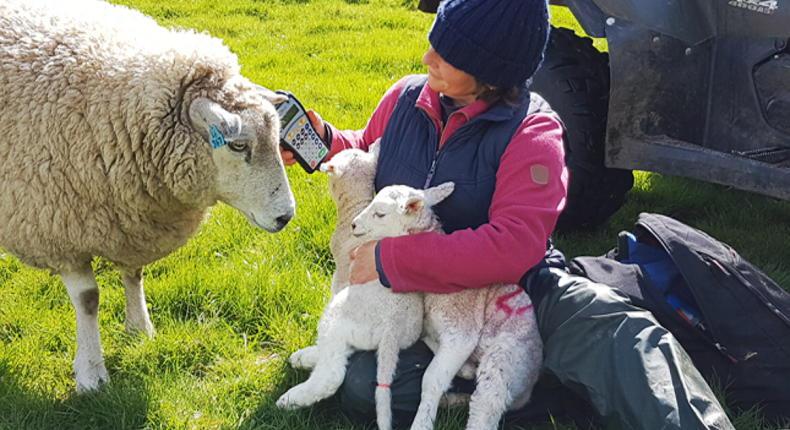
Debbie McGowan performance recording newborn lambs.
IGA webinar
This honest appraisal of a flawed system was delivered by Neil McGowan, who runs Incheoch Farms in Perthshire, Scotland, along with his wife Debbie, as part of a series of webinars hosted last week by the Irish Grassland Association.
Incheoch Farms is a large-scale operation with a flock of 1,200 breeding ewes and 220 suckler cows run over 485ha (1,200 acres) of upland ranging from 400 to 750 feet above sea level.
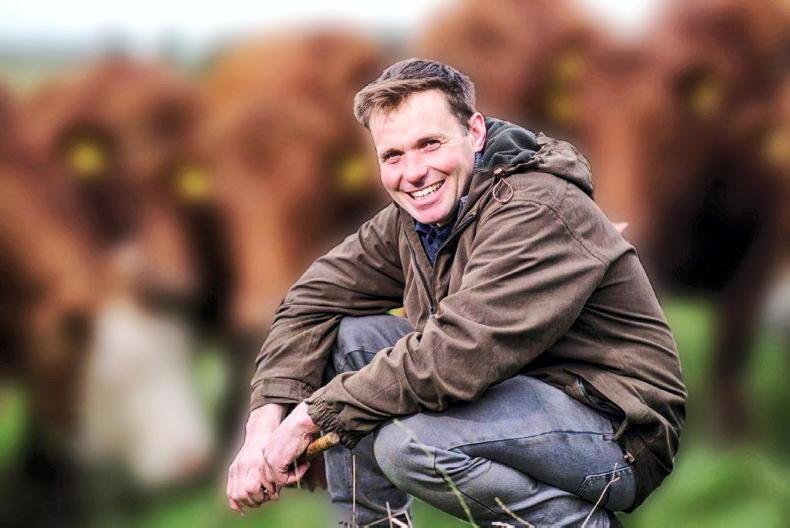
Neil McGowan, Incheoch Farms.
The farm has two full-time staff and also avails of help from Neil’s parents, Finlay and Judy, and sister Clare along with their two children, Tally and Angus.
The farm overlooks a productive area of agriculture to the east which is dominated by horticulture and tillage.
To the north, the landscape was traditionally dominated by Scottish Blackface ewes but the terrain now reflects the reduced sheep population in the Scottish highlands with a mixture of forestry, a grouse and deer farm and some Scottish Blackface ewes on the horizon, along with Scotland’s largest ski resort.
Land type on the farm ranges from good productive upland ground to natural grazing with the farm operated under an environmental stewardship.
Focus on forage
The focus on the farm is to make the best use of what the farm can grow and produce lamb and beef from grass and forage crops.
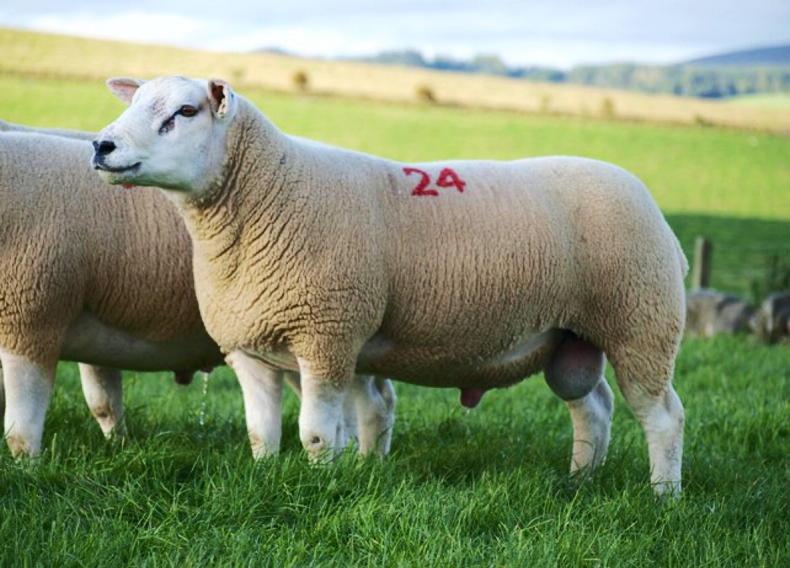
The switch to grass-fed rams was a significant change in direction for the farm but one that has paid off.
The farm has experienced significant change over the last 20 years with the breeding programme changing from a crossbred flock to now comprising a flock of 1,100 Lleyn ewes and 120 Texel ewes.
Neil jokes that when he got married to Debbie she arrived with 40 Lleyn ewes but that they soon realised Lleyns were a good match to the system with the flock originating and bred from these 40 ewes.
Neil says there are three objectives all ewes must satisfy:
“They must behave like a sheep and do all the things we expect from sheep, from ewes lambing themselves to lambs getting up to suckle quickly, and sheep not becoming lame.”“Do a job to be proud of and deliver plenty of prime lambs capable of being finished by the end of the growing season and do this efficiently time and time again.”“Be a thrifty and robust ewe that will last in our environment.” Grass is the dominant crop sown but forage crops are also used to good effect with lambs finished later in the season on red clover leys and forage crops. Ewes are wintered on swedes.
Performance recording
All of these objectives in the breeding programme are closely monitored through performance recording. This year, Neil and Debbie collected performance records on just over 1,200 ewes and their progeny and while it is a big task, Neil says it is the foundation on which their system is built.
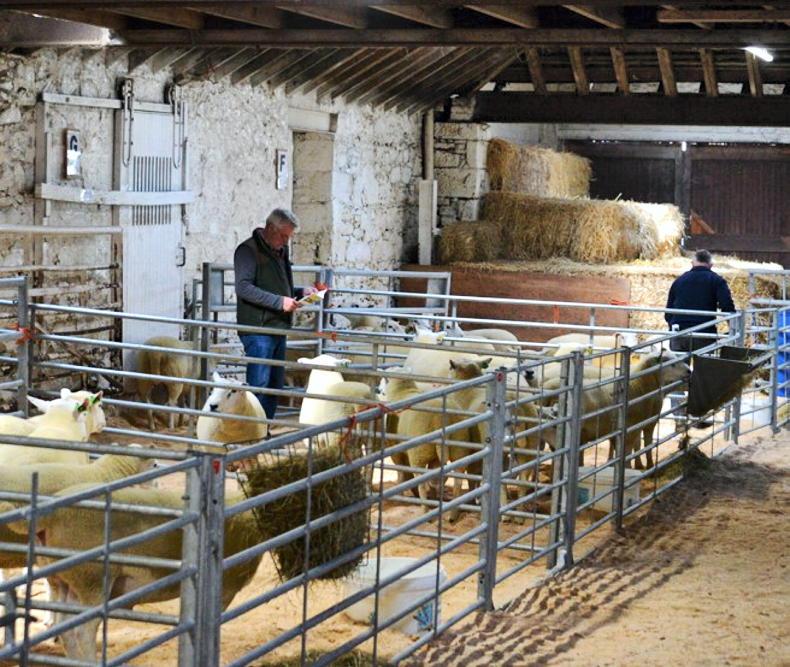
Prospective customers assessing rams ahead of the Working Genes on-farm sale.
“Lambing outdoors makes it trickier but there is no point in trying to produce sheep that other farmers need to lamb outdoors and not doing it ourselves. Recording allows us to keep going back to make sure we are sticking to our flock objectives.
“We put together a programme to promote traits we desired and the type of ewe which has emerged is a sturdy ewe weighing 65kg to 70kg, scans about 185% in a May lambing system and produces an R or a U grade lamb at a 3l/H fat level at 19kg to 20kg carcase weight.”
Records collected at lambing include mothering ability, lambing ease, lamb vigour and birth weights.
In recent years, Neil explains the accessibility of electronic recording equipment has facilitated regular weighing and ewe efficiency to be monitored.

The Lleyn ewes have been a good fit for the system and land type on the farm.
“I think if I was to keep only one thing this figure [ewe efficiency] is the most important for us. We work on [lamb liveweight] 100 days from mid-lambing and divide this by the weight of ewe going to the tup. A one [score] is our target and achieving this means the ewe has weaned as much liveweight as her weight going to the ram.”
This is seen by the McGowans as a really useful tool for comparing performance within the flock and identifying superior performing animals. The careful selection for desirable traits has seen the twinning rate increase from 65% to 75% over the past 10 years and lamb liveweight at 150 days increase by 3.8kg in the same period.
Ultrasound scanning is also practised and the farm generally completes one day’s ultrasound scanning in the Lleyn flock, which typically consists of 250 lambs being scanned, while all Texel lambs in the flock are scanned on another day. Both the sheep flock and suckler herd boast high health status accreditation and are partaking in numerous industry initiatives.
Other traits recently being honed in are worm tolerance and lamb survival. This includes carrying out a faecal egg worm count on 300 lambs individually.

A view of the farm looking east looking down on some of the more productive land.
It is being carried out as part of the Signet breeding programme and a link up with the Lleyn and Texel breed societies with the aim of feeding this data into estimated breeding values (EBVs) and long-term selecting breed lines with worm tolerance characteristics.
The breeding programme for the Texel sheep is no different to the Lleyns with a focus on the commercial market.
“My father started breeding Texels in the late 1980s and after four to five years thought we are not going to get far in the pedigree world [with our breed objectives] so said we would concentrate on the commercial market and we have very much done that ever since.”
The objective when using Texel rams is to improve growth and carcase characteristics and enhance slaughter performance.
“We want to cut the time lambs are on the farm, add a wee bit more growth and a bit more carcase value but it can’t be with any hassle. We can’t have added problems just because they are Texels out of this Lleyn ewe.”
As touched on at the start of the article, the farm has experienced a major switch from competing in society sales to marketing grass or forage-fed rams.
“We were confident that the Lleyns could do it but we were not very confident that the Texels could or what they would even look like. The Texels didn’t look as strong but buyers that got them found them good enough to come back again. They said that although the rams didn’t look as good as rams they had in previous years, by the following year there was no difference with how they looked.”
The move to marketing grass or forage-fed rams led to a switch away from society sales being the main route to market with sales directly off the farm becoming more popular. This did, however, have its downsides. “We were selling the commercial ones at home and were not very good at knowing what to ask. We were also faced with the challenge of everyone wanting first pick and trying to look after repeat customers. So about 10 years ago, we went with a home sale and haven’t looked back.”
The “working genes” sale now includes upwards of 100 Lleyn and Texel rams and also markets bulls at the sale. Neil believes part of the success of the sale is the fact that the farm has developed long-standing relationships with farmers with the sale combining as a social event.
“We built a ring, have a barbecue and put on a bit of hospitality. Us shepherds don’t do it enough and when you look at the economy of what it costs, a couple of rams will pay for it. It is paid back each year and it is good fun.”
The coronavirus pandemic forced a change in 2020 with the farm moving to an online sale where customers could come and view the animals in the three weeks prior to the sale. The sale itself took the format of a timed auction.
“We put a bit of time into marketing and taking videos and photos. We gave an honest appraisal of flaws and pointed out the bad points as well as the good points and I think this helped. We had customers that didn’t come to view animals at all.”
The suckler herd comprises 40 to 50 pedigree Simmental cows which are used to produce bulls for sale, while there is also a small herd of Angus cows that Neil’s sister runs. The remainder of the herd are Luing cows, which are traditional to the area and suit the terrain.
The two systems combine favourably with Neil commenting that the sheep benefit from the presence of a suckler herd.
“We are pretty aware we have a low cost sheep system on the back of a high-cost cow system. If we changed the whole farm over to sheep we would have a high-cost sheep system with cows absorbing some of the cost as we have quite a lot of cattle grass available for ewes for tupping and for grazing early in the season.”
Looking back on the production system utilised over 20 years ago for producing rams for sale, Neil McGowan says it was appalling how much concentrates they were feeding rams to prepare them for sale.
He describes how the farm’s breeding programme found itself caught in an “increasingly competitive feeding race”.
It was a situation which was neither working for the farm or the producer purchasing these rams. The severity of the situation really hit home through attendance at discussion group meetings.

The view of the farm looking north showing the type of terrain at the higher elevation.
“Twenty odd years ago, May lambing was nothing new but there was a college [SRUC] group run by John Vipond and I would go a long to a lot of meetings.
“We were learning from each other’s mistakes and at the end of every meeting, the conclusion to many things was that it was the ram breeder’s fault. As a ram breeder I kind of took that to heart when it was raised that there were too many lamb losses, lambs would not get up to suckle quickly and were not vigorous enough and it was down really to ram breeders not doing their job. It got us thinking what if a ram breeder tried to do it right from a commercial farmer point of view.”

Debbie McGowan performance recording newborn lambs.
IGA webinar
This honest appraisal of a flawed system was delivered by Neil McGowan, who runs Incheoch Farms in Perthshire, Scotland, along with his wife Debbie, as part of a series of webinars hosted last week by the Irish Grassland Association.
Incheoch Farms is a large-scale operation with a flock of 1,200 breeding ewes and 220 suckler cows run over 485ha (1,200 acres) of upland ranging from 400 to 750 feet above sea level.

Neil McGowan, Incheoch Farms.
The farm has two full-time staff and also avails of help from Neil’s parents, Finlay and Judy, and sister Clare along with their two children, Tally and Angus.
The farm overlooks a productive area of agriculture to the east which is dominated by horticulture and tillage.
To the north, the landscape was traditionally dominated by Scottish Blackface ewes but the terrain now reflects the reduced sheep population in the Scottish highlands with a mixture of forestry, a grouse and deer farm and some Scottish Blackface ewes on the horizon, along with Scotland’s largest ski resort.
Land type on the farm ranges from good productive upland ground to natural grazing with the farm operated under an environmental stewardship.
Focus on forage
The focus on the farm is to make the best use of what the farm can grow and produce lamb and beef from grass and forage crops.

The switch to grass-fed rams was a significant change in direction for the farm but one that has paid off.
The farm has experienced significant change over the last 20 years with the breeding programme changing from a crossbred flock to now comprising a flock of 1,100 Lleyn ewes and 120 Texel ewes.
Neil jokes that when he got married to Debbie she arrived with 40 Lleyn ewes but that they soon realised Lleyns were a good match to the system with the flock originating and bred from these 40 ewes.
Neil says there are three objectives all ewes must satisfy:
“They must behave like a sheep and do all the things we expect from sheep, from ewes lambing themselves to lambs getting up to suckle quickly, and sheep not becoming lame.”“Do a job to be proud of and deliver plenty of prime lambs capable of being finished by the end of the growing season and do this efficiently time and time again.”“Be a thrifty and robust ewe that will last in our environment.” Grass is the dominant crop sown but forage crops are also used to good effect with lambs finished later in the season on red clover leys and forage crops. Ewes are wintered on swedes.
Performance recording
All of these objectives in the breeding programme are closely monitored through performance recording. This year, Neil and Debbie collected performance records on just over 1,200 ewes and their progeny and while it is a big task, Neil says it is the foundation on which their system is built.

Prospective customers assessing rams ahead of the Working Genes on-farm sale.
“Lambing outdoors makes it trickier but there is no point in trying to produce sheep that other farmers need to lamb outdoors and not doing it ourselves. Recording allows us to keep going back to make sure we are sticking to our flock objectives.
“We put together a programme to promote traits we desired and the type of ewe which has emerged is a sturdy ewe weighing 65kg to 70kg, scans about 185% in a May lambing system and produces an R or a U grade lamb at a 3l/H fat level at 19kg to 20kg carcase weight.”
Records collected at lambing include mothering ability, lambing ease, lamb vigour and birth weights.
In recent years, Neil explains the accessibility of electronic recording equipment has facilitated regular weighing and ewe efficiency to be monitored.

The Lleyn ewes have been a good fit for the system and land type on the farm.
“I think if I was to keep only one thing this figure [ewe efficiency] is the most important for us. We work on [lamb liveweight] 100 days from mid-lambing and divide this by the weight of ewe going to the tup. A one [score] is our target and achieving this means the ewe has weaned as much liveweight as her weight going to the ram.”
This is seen by the McGowans as a really useful tool for comparing performance within the flock and identifying superior performing animals. The careful selection for desirable traits has seen the twinning rate increase from 65% to 75% over the past 10 years and lamb liveweight at 150 days increase by 3.8kg in the same period.
Ultrasound scanning is also practised and the farm generally completes one day’s ultrasound scanning in the Lleyn flock, which typically consists of 250 lambs being scanned, while all Texel lambs in the flock are scanned on another day. Both the sheep flock and suckler herd boast high health status accreditation and are partaking in numerous industry initiatives.
Other traits recently being honed in are worm tolerance and lamb survival. This includes carrying out a faecal egg worm count on 300 lambs individually.

A view of the farm looking east looking down on some of the more productive land.
It is being carried out as part of the Signet breeding programme and a link up with the Lleyn and Texel breed societies with the aim of feeding this data into estimated breeding values (EBVs) and long-term selecting breed lines with worm tolerance characteristics.
The breeding programme for the Texel sheep is no different to the Lleyns with a focus on the commercial market.
“My father started breeding Texels in the late 1980s and after four to five years thought we are not going to get far in the pedigree world [with our breed objectives] so said we would concentrate on the commercial market and we have very much done that ever since.”
The objective when using Texel rams is to improve growth and carcase characteristics and enhance slaughter performance.
“We want to cut the time lambs are on the farm, add a wee bit more growth and a bit more carcase value but it can’t be with any hassle. We can’t have added problems just because they are Texels out of this Lleyn ewe.”
As touched on at the start of the article, the farm has experienced a major switch from competing in society sales to marketing grass or forage-fed rams.
“We were confident that the Lleyns could do it but we were not very confident that the Texels could or what they would even look like. The Texels didn’t look as strong but buyers that got them found them good enough to come back again. They said that although the rams didn’t look as good as rams they had in previous years, by the following year there was no difference with how they looked.”
The move to marketing grass or forage-fed rams led to a switch away from society sales being the main route to market with sales directly off the farm becoming more popular. This did, however, have its downsides. “We were selling the commercial ones at home and were not very good at knowing what to ask. We were also faced with the challenge of everyone wanting first pick and trying to look after repeat customers. So about 10 years ago, we went with a home sale and haven’t looked back.”
The “working genes” sale now includes upwards of 100 Lleyn and Texel rams and also markets bulls at the sale. Neil believes part of the success of the sale is the fact that the farm has developed long-standing relationships with farmers with the sale combining as a social event.
“We built a ring, have a barbecue and put on a bit of hospitality. Us shepherds don’t do it enough and when you look at the economy of what it costs, a couple of rams will pay for it. It is paid back each year and it is good fun.”
The coronavirus pandemic forced a change in 2020 with the farm moving to an online sale where customers could come and view the animals in the three weeks prior to the sale. The sale itself took the format of a timed auction.
“We put a bit of time into marketing and taking videos and photos. We gave an honest appraisal of flaws and pointed out the bad points as well as the good points and I think this helped. We had customers that didn’t come to view animals at all.”
The suckler herd comprises 40 to 50 pedigree Simmental cows which are used to produce bulls for sale, while there is also a small herd of Angus cows that Neil’s sister runs. The remainder of the herd are Luing cows, which are traditional to the area and suit the terrain.
The two systems combine favourably with Neil commenting that the sheep benefit from the presence of a suckler herd.
“We are pretty aware we have a low cost sheep system on the back of a high-cost cow system. If we changed the whole farm over to sheep we would have a high-cost sheep system with cows absorbing some of the cost as we have quite a lot of cattle grass available for ewes for tupping and for grazing early in the season.”








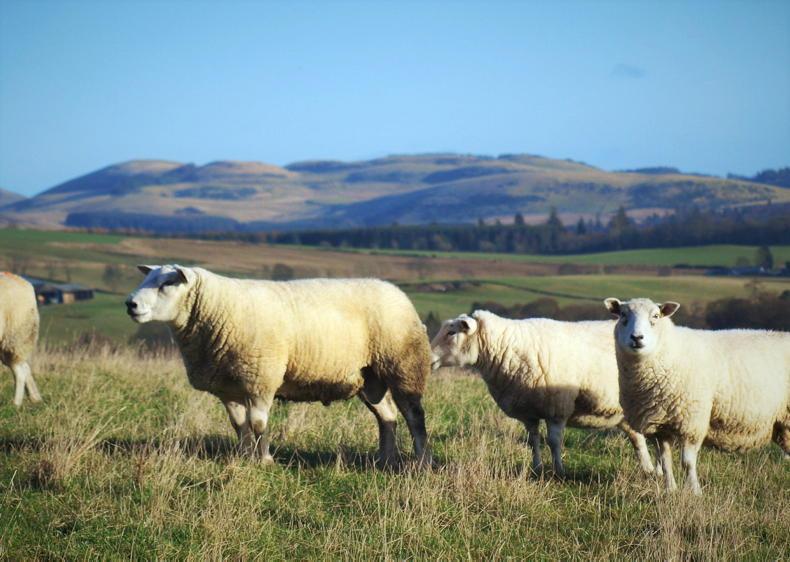




 This is a subscriber-only article
This is a subscriber-only article










SHARING OPTIONS: